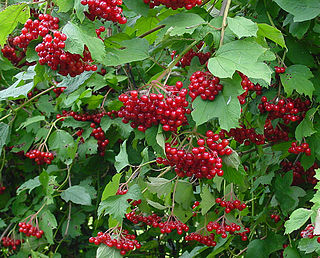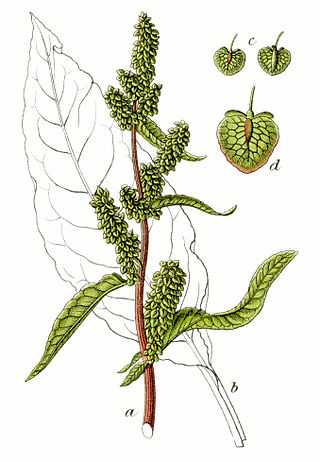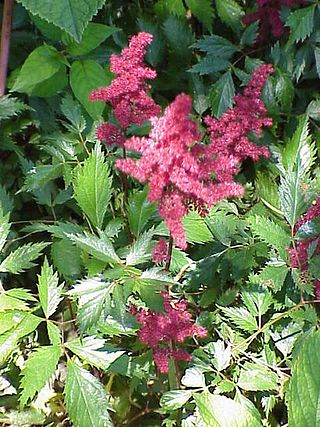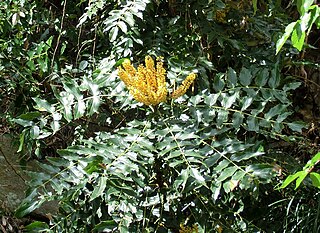
Viburnum is a genus of about 150–175 species of flowering plants in the moschatel family, Adoxaceae. Its current classification is based on molecular phylogeny. It was previously included in the honeysuckle family Caprifoliaceae.

The docks and sorrels, genus Rumex, are a genus of about 200 species of annual, biennial, and perennial herbs in the buckwheat family, Polygonaceae. Members of this genus are very common perennial herbs with a native almost worldwide distribution, and introduced species growing in the few places where the genus is not native.

Gentianaceae is a family of flowering plants of 103 genera and about 1600 species.

Gyalshing District or Geyzing District is a district of the Indian state of Sikkim. Its headquarter is Geyzing, also known as Gyalshing. The district is a favourite with trekkers due to the high elevations. Other important towns include Pelling and Yuksom. Local people also call it as Pallo-Sikkim and Sano-Sikkim commonly.

Ethnobiology is the scientific study of the way living things are treated or used by different human cultures. It studies the dynamic relationships between people, biota, and environments, from the distant past to the immediate present.

Anaphalis is a genus of herbaceous and woody flowering plants within the family Asteraceae, whose members are commonly known by the name pearl or pearly everlasting. There are around 110 species with the vast majority being native to central and southern Asia. There is one species native to North America that is fairly well known and popular in cultivation, namely the western pearly everlasting.

Centranthera is a genus of plants in the family Orobanchaceae. The genus is distributed in Asia. There are about 10 species in this genus, and the majority have funnel-shaped flowers. In Nepal, Centranthera cochinchinensis is reportedly used an alternate fodder.

Astilbe is a genus of 18 species of rhizomatous flowering plants within the family Saxifragaceae, native to mountain ravines and woodlands in Asia and North America. Some species are known by the common names false goat's beard and false spirea.

Khangchendzonga National Park, also Kanchenjunga Biosphere Reserve, is a national park and a biosphere reserve located in Sikkim, India. It was inscribed to the UNESCO World Heritage Sites list in July 2016, becoming the first "Mixed Heritage" site of India. It was included in the UNESCO Man and the Biosphere Programme. The park is named after the mountain Kangchenjunga, which is the third-highest peak in the world at 8,586 m (28,169 ft) tall. The total area of the park is 849.5 km2 (328.0 sq mi).
Shingba Rhododendron Sanctuary is a nature park in the Indian state of Sikkim. It has forty species of rhododendron trees. It is located in the Yumthang Valley of Flowers north of Lachung in North Sikkim district. Bird species found in the park include Wood snipe and Hoary-throated barwing. The sanctuary is part of the Sacred Himalayan Landscape.
Kyongnosla Alpine Sanctuary is a nature reserve in Gangtok district, Sikkim, India. It is situated around the area adjoining the Tsomgo (Changu) lake along the Nathula Road. Located about 31 km (19 mi) east of Gangtok, the capital of Sikkim, this sanctuary covers an area of about 31 km2 (12 sq mi), and extends from the "15th Mile" police check point up to and along the ridges bordering the Rong Chu Valley and Lake Tsomgo.
Biocultural diversity is defined by Luisa Maffi, co-founder and director of Terralingua, as "the diversity of life in all its manifestations: biological, cultural, and linguistic — which are interrelated within a complex socio-ecological adaptive system." "The diversity of life is made up not only of the diversity of plants and animal species, habitats and ecosystems found on the planet, but also of the diversity of human cultures and languages." Research has linked biocultural diversity to the resilience of social-ecological systems. Certain geographic areas have been positively correlated with high levels of biocultural diversity, including those of low latitudes, higher rainfalls, higher temperatures, coastlines, and high altitudes. A negative correlation is found with areas of high latitudes, plains, and drier climates. Positive correlations can also be found between biological diversity and linguistic diversity, illustrated in the overlap between the distribution of plant diverse and language diverse zones. Social factors, such as modes of subsistence, have also been found to affect biocultural diversity.

Linnaea is a plant genus in the honeysuckle family Caprifoliaceae. Until 2013, the genus included a single species, Linnaea borealis. In 2013, on the basis of molecular phylogenetic evidence, the genus was expanded to include species formerly placed in Abelia, Diabelia, Dipelta, Kolkwitzia and Vesalea. However, this is rejected by the majority of subsequent scientific literature and flora.

Oroxylum indicum is a species of flowering plant belonging to the monotypic genus Oroxylum and the family Bignoniaceae, and is commonly called Indian trumpet tree, oroxylum, Indian trumpet flower, broken bones, Indian caper, scythe tree or tree of Damocles. It can reach a height of 18 metres (59 ft). Various segments of the tree are used in traditional medicine, where it is known as Shyonaka or Sona Patha.

Dendrophthoe is a genus of hemiparasitic shrubs found in Asia and Australia known as mistletoes. The genus was described by German naturalist Carl Friedrich Philipp von Martius in 1830. Species in this genus have a variety of reported uses in the medical traditions of the region, most notably in Nepal.

Bergenia ciliata is a plant species in the genus Bergenia, deciduous in USDA Zones 5 to 7, but usually remain semi-evergreen south of Zone 7. It is found in Northern India in Uttarakhand and Himachal Pradesh. This flower is related to the famous Phool Dei Festival celebrated in Uttarakhand. It is commonly known in India as Pathar phor buti. Also found in mountain areas of West Bengal, like Kalimpong, and Darjeeling. Afghanistan, south Tibet, Northern Nepal, Bhutan.

Allium sikkimense is a plant species native to Sikkim, Tibet, Bhutan, Nepal, India and parts of China. It grows in meadows and on the edges of forests at elevations of 2400–5000 m. The species is cultivated as an ornamental in other regions because of its strikingly beautiful blue flowers. It is used medicinally in the Sikkim Eastern Himalayas.

Berberis napaulensis Nepali: जमाने मान्द्रो is a shrub in the family Berberidaceae described as a species in 1821. It is native to China and the Himalayas. This species is used medicinally throughout the Sikkim Eastern Himalayas.















